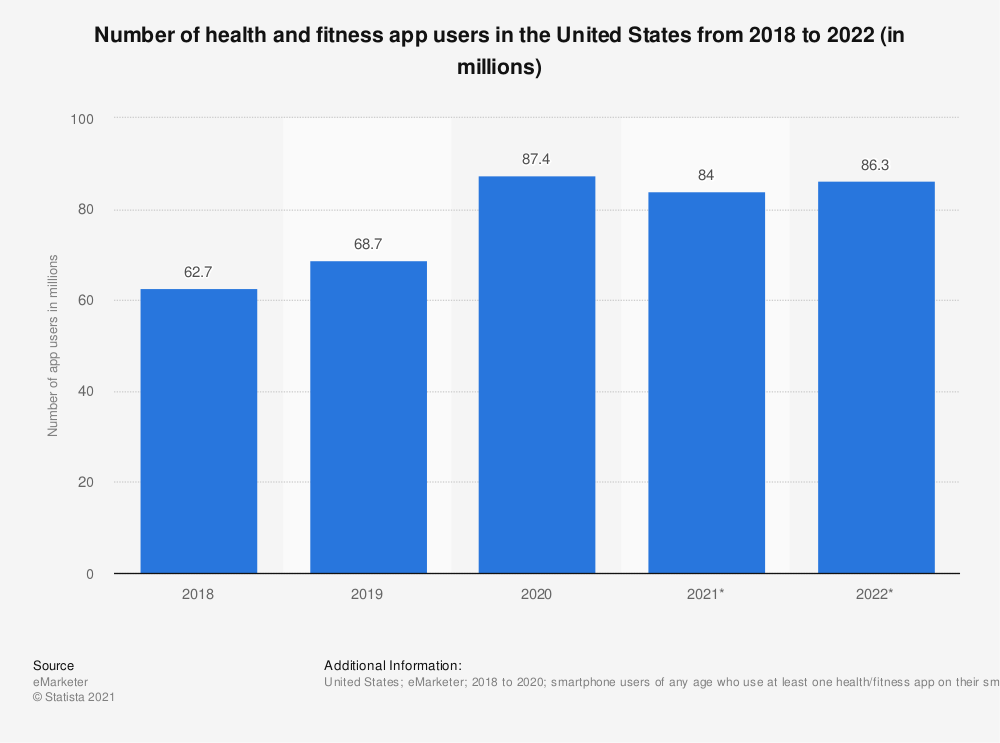Contents
IoT in the Fitness Industry: Devices, Use Cases & Tips
Published: July 8, 2024
25 min read
In this article, you'll learn:
1
📋 Fitness IoT Use Cases
2
🏆 Our Expertise in Wearables Integration: Platoon Fit & SportPlus
3
🤖 Internet of Things Tech Stack in the Fitness Industry: Devices & APIs
4
❓ FAQ on IoT in Fitness
5
💡 Takeaways
The Internet of Things is actually an unbelievably broad concept. By the year 2025, the number of health IoT devices is expected to reach 64B, which is 8x more than the population of the Earth. It can include anything from a 1-Million-Dollar car to a smart knife. Plus, according to McKinsey’s research, 127 new IoT devices get connected to the Internet every single second.
For you as a business owner in the fitness industry, it means that a lot of your (potential) users probably own a fitness tracker and measure the basic metrics of their body like heart rate and walking distance on a regular basis. This is something you should live up to — it’s no longer a way to stand out.
What it surely doesn’t mean is that you have to build your own unique fitness tracker. You can simply partner up with a company of your choice by buying their API/SDK, and use the functionality they provide.
{ rel="nofollow" target="_blank" .default-md}*)](https://cdn.sanity.io/images/ordgikwe/production/f599d4ae088fa45569a403fa7190fa79bd061ab7-1000x750.jpg?w=1000&h=750&auto=format)
A fitness IoT system can provide valuable health data that allows companies customize their digital workout solutions (image by Purrweb UI/UX Studio)
The number of available fitness IoT devices is really impressive, meaning you have quite a range to choose something suitable for your specific business needs. Apart from IoT-based equipment and wearables, we’ll be talking about IoT use cases and answer some of the most popular questions on this topic.
Before that, we’d like to give you a round-up of what you might be able to do with all those devices to optimize your business processes and provide better services.
We’re going to use the word API quite a lot so, in case you’re not familiar with the concept, we highly recommend watching this video. It gives a great introduction to what it is.
📋 Fitness IoT Use Cases
Internet of Things devices, supported by companion application development, have a truly broad application in the fitness industry, enhancing user engagement and personalization. They help to customize the user experience, enable immersive home training, and even offer easier equipment maintenance to those who have offline fitness studios.
Let’s review each one of these use cases in detail.
# 1: Health and Fitness Monitoring & Workout Customization
Workout customization is one of the most important parts of doing any kind of sport. Basically, users themselves tend to customize their workout in simple ways — do less than an on-demand upper body workout stream tells them to, change an exercise a bit so it’ll be better suited to their physical capabilities and equipment, etc.
However, most of them are no professionals and probably aren’t able to find the right balance between the comfort and challenge needed for progress on their own. Your job here is to make customization as precise as possible, even if it’s a digital product — and IoT fitness devices are a great way to do it.
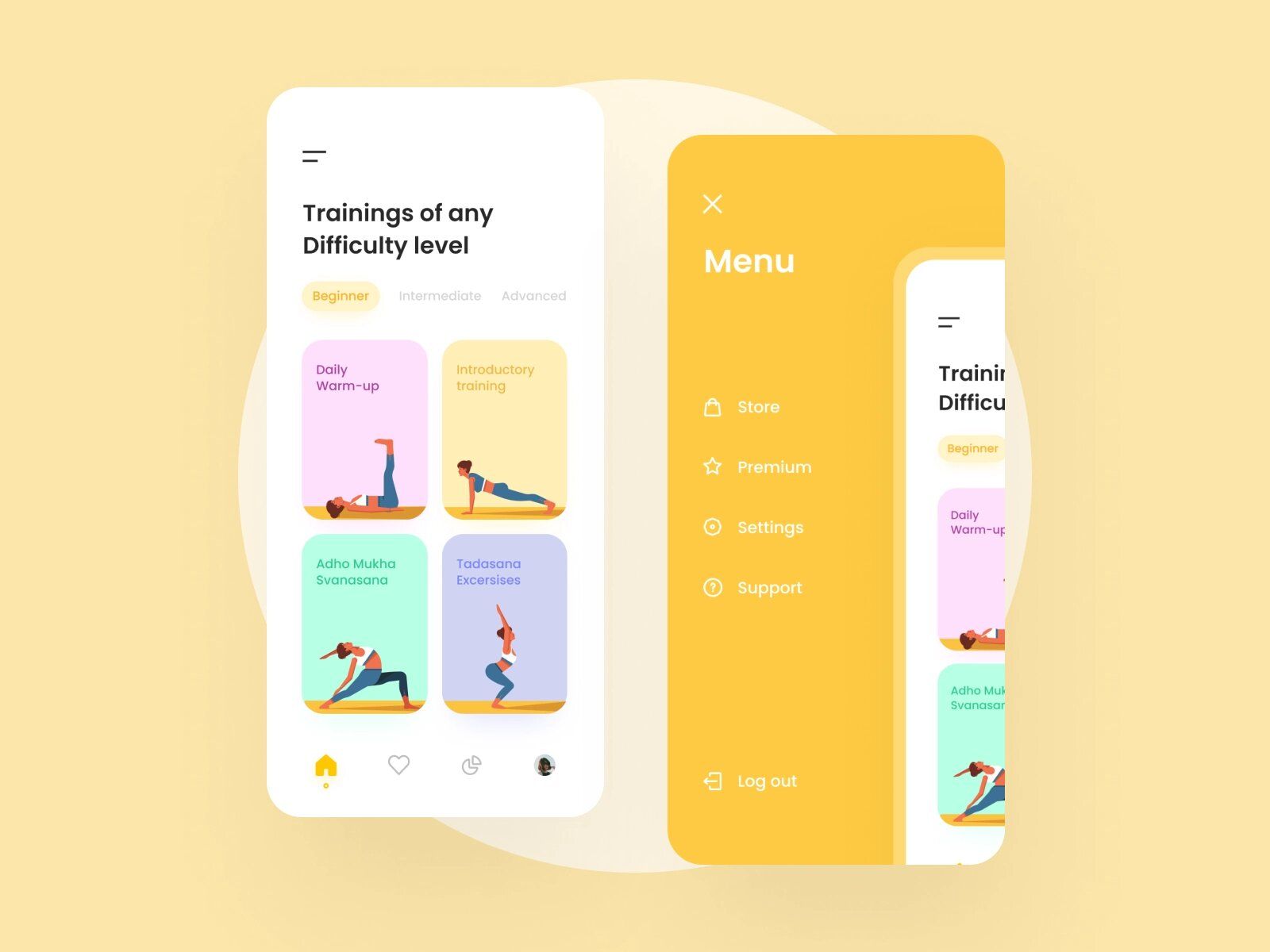
Modern fitness apps collect training data (or even sleep data) using smart sensors and send it to each user’s mobile phone (image by Dmitry Lauretsky)
For example, even the most affordable fitness trackers on the market are able to measure the heart beat, burned calories, walk/run distance, and count steps. With only that information, you can significantly adjust workouts.
If the data tells you that the person is getting enough walk (aka leg exercise), you can consider offering them more upper body or abs workouts. The general idea is to make sure customers are keeping a healthy balance in exercising different muscle groups. Surely, it also needs to be tailored to customers’ fitness goals.
Another example of a custom approach could be spotting any abnormal activities in users’ metrics. Let’s say a 45-year-old user’s heart rate after most exercises ranges from 140 to 160 every single time. But one day the wearable you’ve integrated spots a significant increase to 200 beats per minute.
Of course, you’re neither responsible nor entitled to give out medical advice (unless you have the necessary qualifications). However, what you can do is point that out for a user and offer to see the doctor.
Luckily, you don’t have to do such adjustments manually. The market offers quite a lot of Machine Learning (ML) tools like Amazon Personalize that allow making content customization automatically.
If you’re interested in how to build a mental health app, or would like to learn more about ML in the wellness industry, check out our article on Machine Learning and Artificial Intelligence in the meditation apps:
The best way would be to mix your own expertise with machine learning tools. For example, your fitness specialists can create different sets of workouts that will be then offered to customers using machine learning and based on users’ goals, preferences, and previous activities.
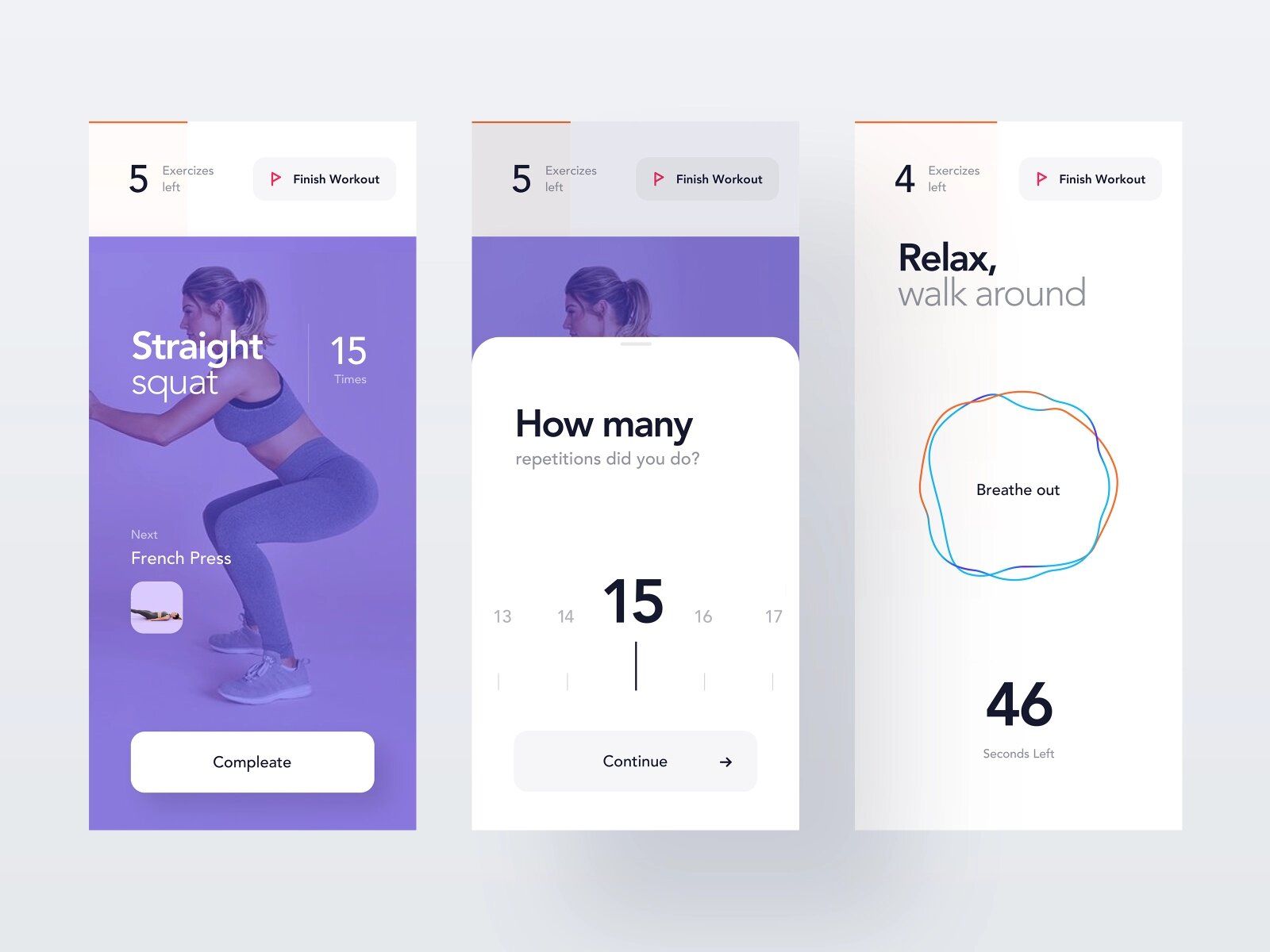
Fitness IoT units like fitness bands with wireless sensors allow tracking fitness data like a user’s heart rate (image by Den Klenkov)
Plus, with the help of Internet of Things devices, you can make progress tracking easier. It’s much (technologically) simpler than customizing workouts, but as much important. For example, a user’s goal is to be able to run 5 km in 30 minutes without any breaks. Fitness trackers, smart clothing, or other suitable Internet of Things devices are able to measure each movement of this user and visualize how/if they’re progressing.
Visualization is a place for you to be creative and choose something you find the best. It can be a progress bar, a column graph, etc. Alternatively, you can add several visualization options so users can choose on their own.
Then, you can make content recommendations on how to reach their goal faster. In our example, it can be cardio workouts targeted at stamina improvement and joint strengthening.
# 2: Immersive Training
During the COVID pandemic, populations’ fitness habits have drastically changed — more and more people prefer working out from home. At first, it was just a necessity for those who wanted to be fit during lockdowns, but then people started to realize that home workouts have many benefits. Thus, they were purposely choosing digital fitness experiences over offline ones.
According to Statista, the number of unique fitness app users jumped by 20M in 2020, just after the beginning of the pandemic, and is going to be stable in the near future.
Find more statistics at Statista
Nevertheless, lack of social interaction and simply presence of other human beings while exercising might be discouraging. So, how сan you as a fitness business owner contribute to solving the problem without risking your users’ health?
Virtual Reality (VR) technologies might be the solution. First of all, with the help of VR, you can create online group training in a shared digital environment. This way, users get to experience mutual support and motivation on their fitness journey.
Another problem that VR technologies can help with solving is the lack of engagement and motivation because of the repetitive routines. From this perspective, VR can offer you a lot of workout gamification. The diversity is really impressive — users can do skiing, slice shells while trying to dodge obstacles, swim with sharks, or meditate in the Alps.
Here’s an example of a VR application for fitness gamification:
Additionally, you can allow real-time activity sharing by creating leaderboards or rooms where people join and see participants’ progress (post-workout as well as at the very time). This can be simply done by enabling data transfer not only to users’ home screens but to the leaderboards/rooms as well.
Of course, none of this can replace real-life experiences. However, it’s an amazing alternative for those who want maximum comfort & safety along with great fitness experiences.
It surely doesn’t mean that offline fitness studios are out of the game — they’re still quite popular among fitness lovers. Even more to that, offline businesses substantially benefit from using IoT technologies, which we’ll talk about in the next subsection.
# 3: Asset Management
Another thing you can use the Internet of Things devices and systems for is equipment management. It might be more relevant to those who have offline gyms, however, such technology can also be used in the online industry. Surely, we’ll talk about both of them.
So, in the offline business, you can use such technology to make data-driven decisions about how to manage your assets — not only exercise equipment but practically anything you want to. It can be anything from a coffee machine in the lobby to lockers.
The first technology you can use is Smart Weight Pin from a company called Smart Health Clubs (further — SHC). The main function of this device is to collect data from selectorized and plate-loaded equipment and send it to the cloud for storing purposes.
Primarily, the idea is to track gym visitors’ activities on most of the weightlifting equipment — the weight itself, number of reps, tempo, etc. It gets recalculated every 25 seconds for maximum accuracy.
As of now, it has a lot to do with workout customization since you can then share this data with fitness professionals and display it in the app so as to use it while planning the workouts, for example. However, it’s only one side of a coin.
By placing it on every machine you get to see which ones are used a lot. That is, if you notice that a certain type of machine next to the window is the most actively used, you can simply rotate it with a one of the same kind that doesn’t get as much “daily strain.” This way, you can extend the machines’ lifetime, which surely reduces your depreciated costs.
{ rel="nofollow" target="_blank" .default-md}*)](https://cdn.sanity.io/images/ordgikwe/production/156d26f068f3d18132b70f0576ea582101a95feb-1600x1200.jpg?w=1600&h=1200&auto=format)
Equipment maintenance is another way of using IoT-based wireless sensors (image by 没有肚肚的杜杜)
Another solution we’d like to mention is a smart sensor from ECOFIT Networks. What’s great about their sensors is that it’s compatible with most of the devices on the market. The company handles all of the backend hustle (including sensor setup, data collection, aggregation, and visualization). You as a potential sensor user can then access the data from any device using their software.
There’s no information on whether it’s possible to integrate their client software with the already existing software you’re (possibly) using for the workflow management so as to use everything in one place. However, in case you’re interested, it’s not a problem at all to ask this question during your personal demo presentation that ECOFIT offers. Alternatively, you can ask your Tech Partner to clarify all the technical details.
The software provides a lot of useful information in the reports:
- Usage summaries (weekly/monthly/quarterly).
- Critical-state reports that show you the equipment that requires repair or replacement.
- Utilization periods.
- Rotation plans and recommendations for maximum longevity.
- Equipment balancing. In case there’s a shortage/excess of some equipment, the software can guide you on how to deal with the issue.
Apart from managing exercise machines, you can also place the sensors on other assets in your studio. For example, if it’s a locker that’s being used too much, you can ask your administrators to give keys to the ones that aren’t used that often.
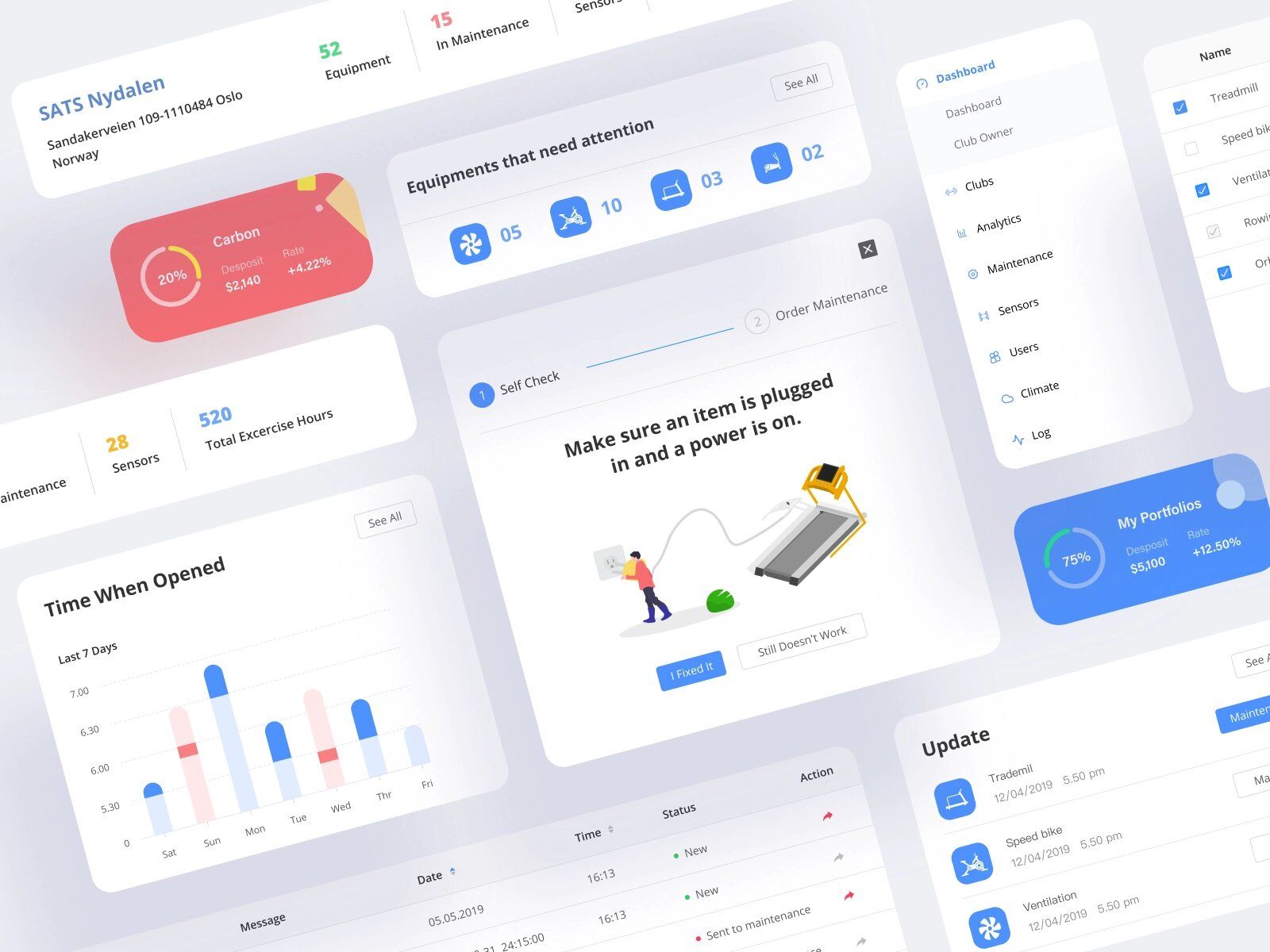
To reduce the strain that gym equipment gets, especially from group fitness, you can track its usage with help of IoT technology and take appropriate measures to prolong its usability (image by Syed Raju)
Yet, how сan online businesses use such IoT devices? Let’s say your business model implies sending clients some sort of equipment for exercising — be it smart dumbbells or something bigger like a treadmill. To be more precise, it can be a premium 1-year subscription that might include replacing members’ equipment once in a while.
So, if you place such sensors on the equipment you’ll send to the users, you’ll be able to track if there’s any need for replacement or repair. An additional benefit is that you’ll be able to see if the need is caused by something a user isn’t in control of or it’s the result of misuse.
Practically, the concept is similar for both offline and online businesses. However, if you want to apply such technology for the online one, you might have to be a little more creative in finding a way of doing it with as little additional costs as possible.
We also have an article that covers app development for offline businesses:
🏆 Our Expertise in Wearables Integration: Platoon Fit & SportPlus
Our team, including fitness mobile app developers, has extensive experience in integrating IoT devices with fitness products. In this section, we’re going to share how we developed MVPs for 2 outstanding fitness projects that featured heart rate sensors and exercise equipment — Platoon Fit and SportPlus.
Platoon Fit
Platoon Fit is an online workouts provider with a special emphasis on health monitoring gadgets. The company focuses on guided training sessions featuring video workouts. Their goal was to find a Tech Partner who’ll help them to deliver an MVP with a special request of fitness IoT integration.
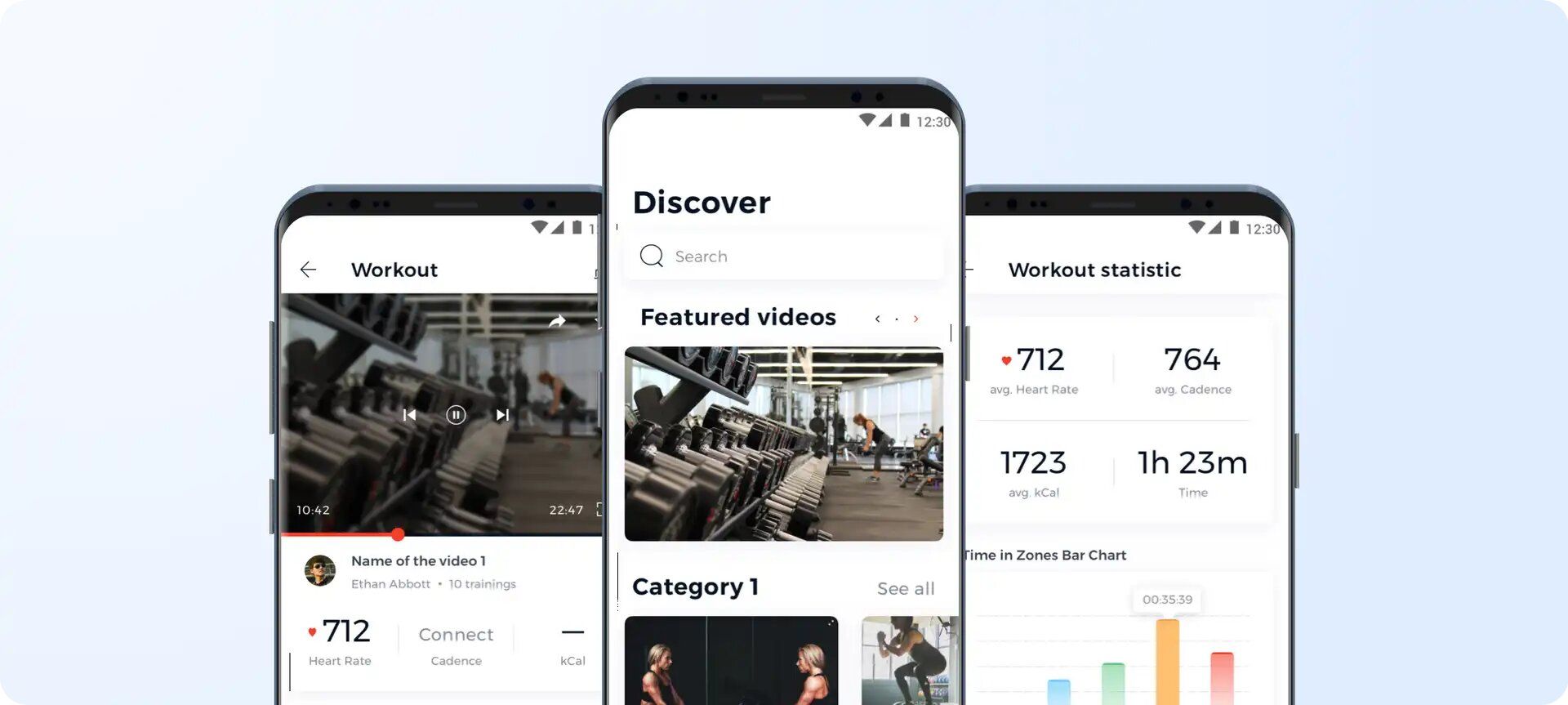
Platoon Fit is an amazing example of how mobile fitness applications can use IoT technologies to improve their services (image by Stormotion)
Apart from implementing seamless UX design and features that would help to reduce the abandonment rate, our team needed to integrate a data transaction system that was going to connect cadence and heart rate sensors with the Platoon Fit application.
For all challenges including IoT integration, Stormotion has created a team of 2 Developers, a Designer, and a Project Manager that were closely cooperating with the Platoon Fit teams. To find the most suitable Tech Stack for health monitoring devices integration, we’ve spent 4 weeks on testing and prototyping.
SportPlus
SportPlus is actually an amazing case for this article since it’s one of the most challenging ones that we got to work on. So, the company offers different exercise machines and equipment. SportPlus wanted to have a dedicated app that would work with all of their devices — and that’s where the challenge begins.
{ rel="nofollow" target="_blank" .default-md}*)](https://cdn.sanity.io/images/ordgikwe/production/c4050a6c467b1d20533ec8b966f475e5f5a63185-2784x1778.jpg?w=2784&h=1778&auto=format)
Fitness classes and group workouts in modern gyms are often modified with IoT gym equipment from treadmills to wireless heart rate sensors (image by SportPlus)
The problem is that most of the machines they sell have different protocols — technically, it’s a language that we use to communicate with the device. In this case, two exercise bikes that may even look similar might be based on different protocols.
To explain our solution, we first need to make a quick intro in the communication process:
- We send a certain set of bytes (data) in a specific order and format to an IoT device.
- The device then processes the data and sends us a bunch of bytes back.
Even though creating sets of bytes for each device separately is challenging enough, the main issue was taking all possible protocols into account to create an app that supports each one of them.
So, what we did to make the SportPlus app compatible with the protocol was taking an already functioning app from another vendor and connecting it to the exercise machine. Then, we performed some physical activities to get data running between the app and the device, and then we snooped it — meaning that we “pumped out” the bytes to see which format and order were used to send and receive them.
🤖 Internet of Things Tech Stack in the Fitness Industry: Devices & APIs
In the first section, we’ve mentioned quite a lot of various Internet of Things devices that you can use to provide better services. Now, we’d like to talk about devices in detail, taking into account those that are suitable for diet and nutrition app development:
- What options are there on the market?
- What are the most trustworthy providers?
- How do I find the one suitable for me?
We provide this information so you know what your potential partners/IoT device providers could be. In case you want to develop your own one, getting inspiration from existing ideas might be useful as well!
Fitness Trackers & Other Wearables 📲
The wearables market is quite a big part of the fitness industry nowadays. Their popularity is understandable — a lot of them are affordable and they offer quite a wide range of functionality. Mostly, people use fitness trackers, however, the market offer goes far beyond it.
Let’s say a couple of words about fitness trackers. The most well-known options are Apple Watch, Samsung Galaxy Watch, Fitbit, Garmin, Nike Fuelband, etc. If you want something for a low budget, it might be Xiaomi, Huawei, Wyze, Amazfit Bip, and so on. All of them have basic (necessary) fitness tracking functionality. Normally, the more expensive options provide more advanced features and are considered multi-functional smart watches rather than just fitness trackers.
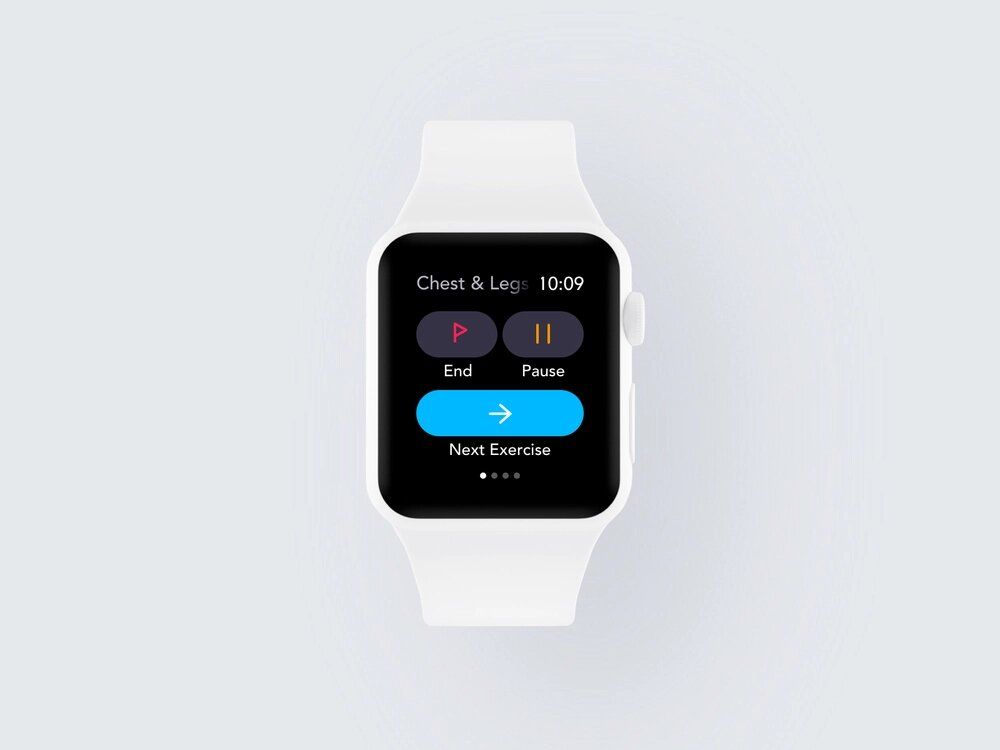
Wearable fitness trackers measure various health data and share it with fitness apps using smart sensors (image by Den Klenkov)
Moreover, the market has quite a few smart rings. Oura Ring, for example, is able to measure daytime/workout heart rate, its variability, temperature, steps, analyze sleep and phases of relaxation as well as stress throughout the day, etc. Other options are BodiMetrics CIRCUL, Sleepon, Circular, etc.
There are also devices for more targeted use like temperature control. Such devices are normally used for cardio training — active exercises significantly increase body temperature, but if it goes too high, our bodies lose power.
With knowing when the temperature is higher than our bodies can be active at, users can take appropriate measurements and track progress. One of the most trustworthy vendors on the market is CORE. Some fitness trackers measure body temperature as well, however, a dedicated device normally has much more advanced functionality.
Additionally, there are small wearables to improve endurance through breathing techniques like Airofit. Surely, these ones aren’t for fitness only, however, any person with regular sporting activities could benefit from having a more stable and “resilient” breath.
Smart Clothing 👕
Technically, smart clothing is another category of smart wearable devices, however, it’s so diverse itself that we decided to dedicate a separate subsection to it. Smart fitness clothing can include T-shirts, vests, leggings, sneakers, socks, underwear, and many others. Let’s take a look at some of the most trustworthy and/or progressive suppliers.
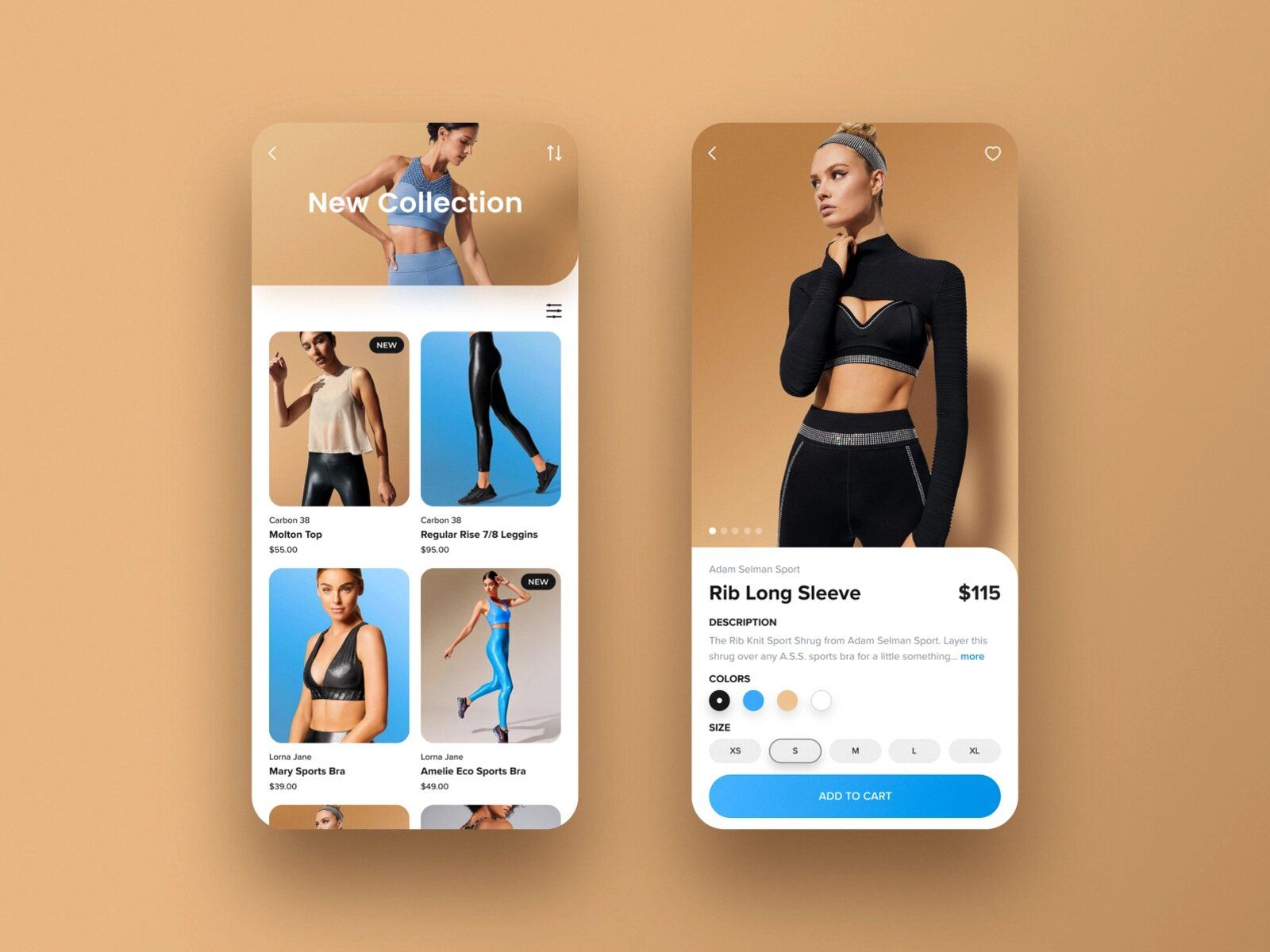
Such a wearable device like smart shorts can also be used by trainers for tracking participants’ performance during group fitness (image by Jakub Bobuski)
One of the first smart activewear providers was Wearable X’s Nadi X yoga pants. The clothing has integrated sensors that analyze users’ movement to then provide feedback and guidance with help of haptic vibrations. Pants come with a branded yoga app and get connected to users' phones through a dedicated detachable charge.
Another product worth attention is Ambiotex’s tank tops and T-shirts. They’re able to measure heart rate and its variability, anaerobic (breath) performance, and provide electrocardiogram (ECG). The data is displayed in the app that also provides workouts with customization. Other providers of clothing with heart rate monitoring functionality are Komodo’s sleeves and Hexoskin’s smart wear.
If you’d like to offer your users something more indiscrete but not less effective, you could take a look at smart socks from Sensoria. They analyze how one’s feet are working and provide instructions on how to prevent injuries, track cadence, tempo, etc. They also provide upper body clothing.
There’s also a device for tracking muscles’ activities from the company called Athos. They use EMG (electromyography) technology along with an Artificial Intelligence system and a mobile app. They’re focused on analyzing injury risks and providing muscle activity biofeedback for further analysis and physical activity customization.
For tracking biometric activity via using smart underwear, take a look at such by SKIIN. The functionality includes measuring heart rate, core body temperature, counting steps, analyzing posture, and tracking location. There are also some features to be implemented in the future like ECG monitoring, respiration rate measuring, etc.
Smart Mats 🧘
Another IoT device in the fitness industry is smart exercise & yoga mats. Such devices are able to analyze your posture and positions to provide recommendations on how to work out without hurting yourself, count exercise repetitions, track progress by saving previous workout data, and much more.
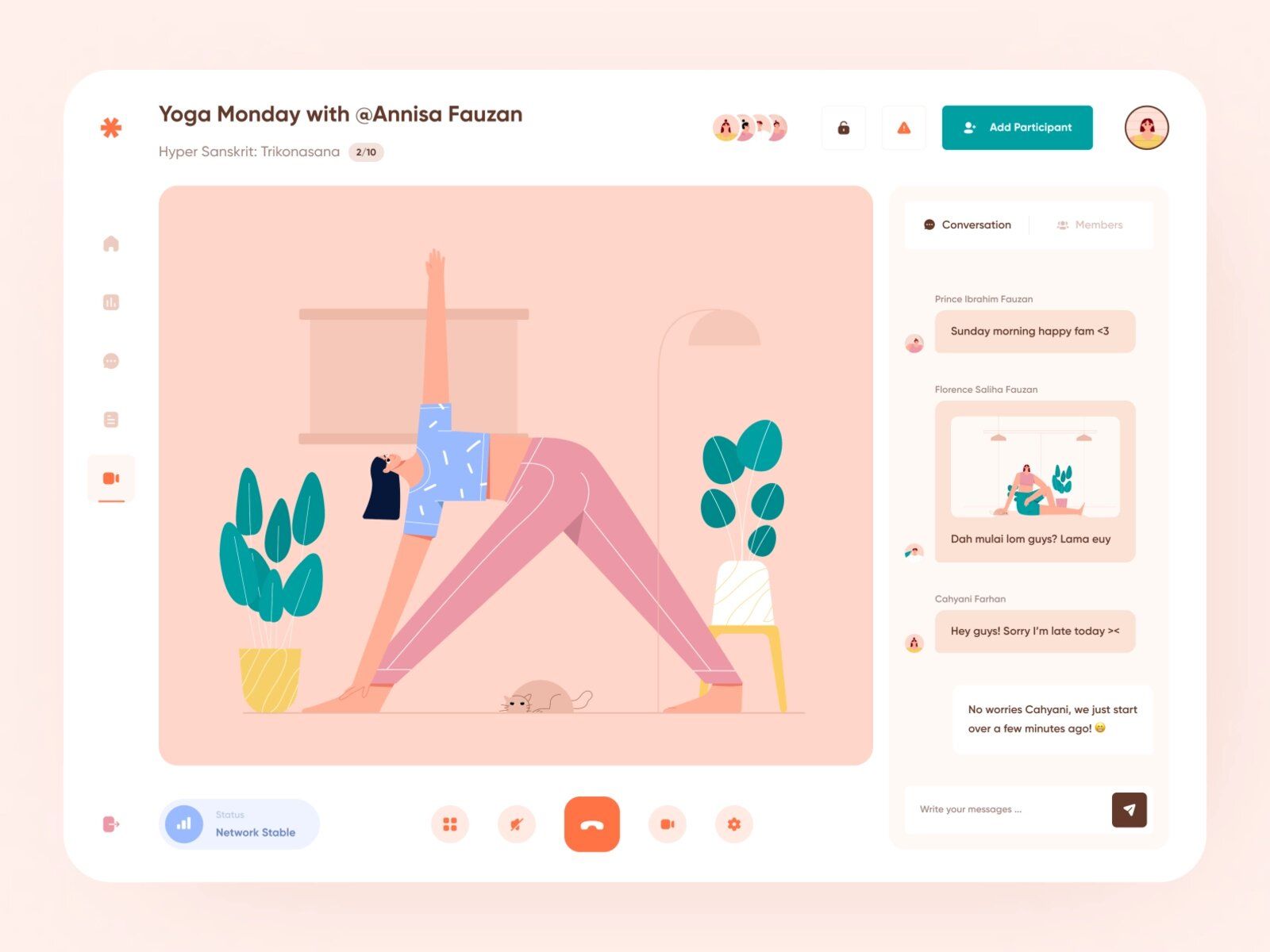
Intelligent yoga mats aren’t that popular but can actually provide an amazing smart gym experience (image by Farhan Fauzan)
To be honest, there are quite a lot of smart mat providers, which makes it hard to choose one. So, here’s the list of the ones we’d reach out to if we were to find partners in this industry:
- YogiFi.
- SmartMat.
- Otari. It also has a built-in AI-based camera that watches people exercise and provides real-time voice instructions to prevent injuries and improve technique. It’s a new product so it might be your chance to be one of their first partners.
In case your business has to do with yoga, you can follow this link to take a look at our yoga app development services:
Smart Equipment 🏋️
To begin with, it’s essential to keep your business model in mind. In case you want to implement smart equipment into your offline business, it’s going to be one approach — you might not have to worry about size and dimensions, weight, setup complexity, etc.
However, if it’s going to be shipped to users for personal at-home use, you’ll have to keep in mind that each home has a different amount of space to set up the equipment. Plus, high-tech equipment usually costs respectively, which means that you should clearly define your target audience.
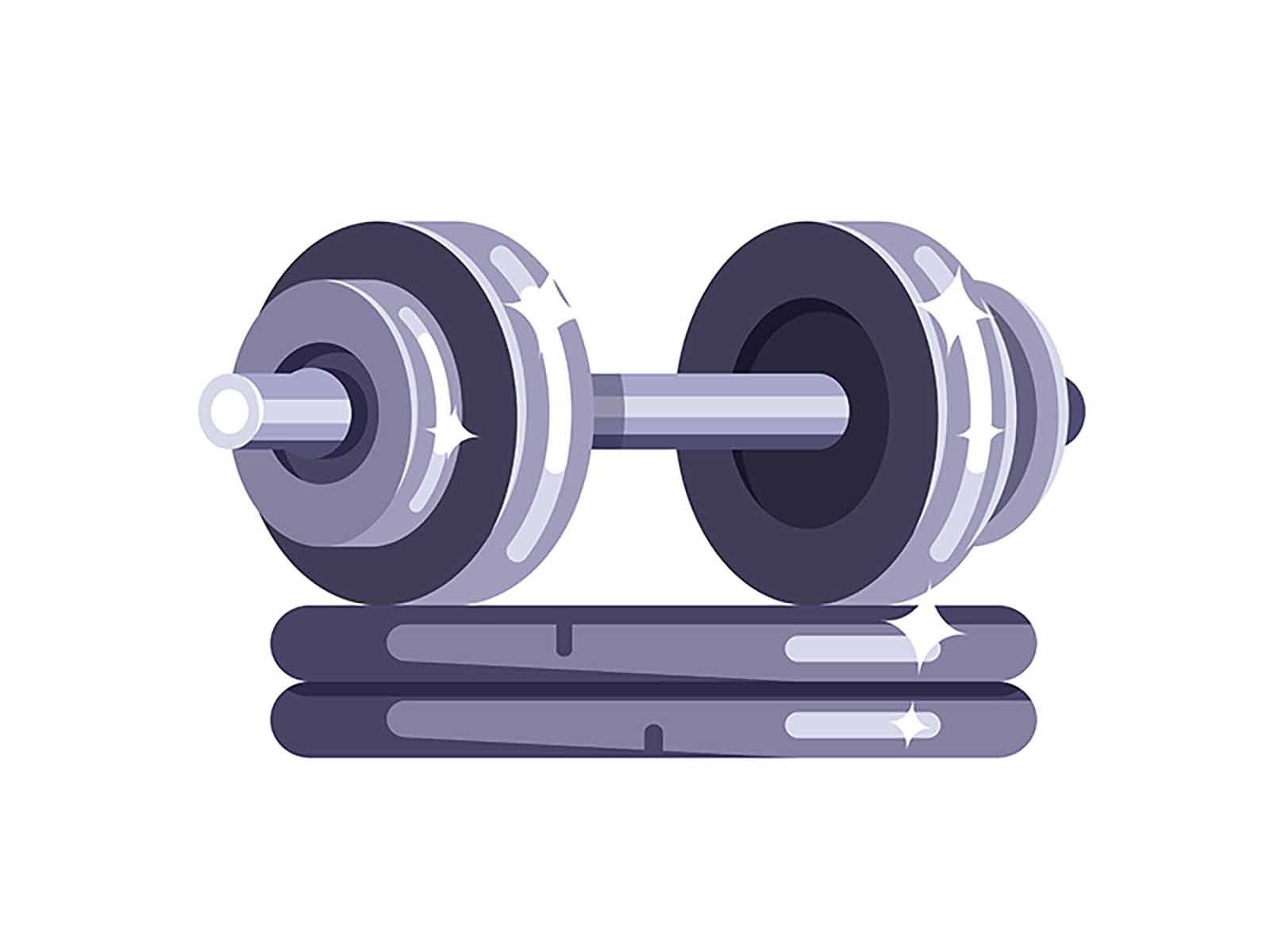
IoT technology-based equipment doesn’t necessarily have to be a wearable device — a lot of options are also available as smart equipment like dumbbells (image by Nikita_Krushko)
Let’s look at some examples. If you want stationary bikes as your IoT device, your most reliable partner might be Peloton. They’re one of the market leaders and have a well-functioning smart system. Their bikes are equipped with 2 sensors for data collection. This data gets to users’ displays and shows them the measurements (revolutions per minute, pace, resistance, etc.).
If you’d like to learn more about building an app that’s integrated with smart equipment, feel free to follow the link to this article:
Furthermore, there are smart dumb- and kettlebells that can automatically adjust to users’ strenght and possibilities. We’ll link those from JaxJox
JaxJox as an example, but the market has quite a lot of alternatives. The company also has smart foam rollers that have a lot of recovery modes and can provide recommendations on that.
Some companies also provide home gym kits, often developed through what is prototyping in IoT, with a system of connected devices. Users normally can buy kit elements separately, but their true potential is revealed when united. Let’s take Tonal as an example. The company offers a device with functionality really close to the offline gym experience. Their Artificial Intelligence technology adapts to clients’ strengths and changes exercises dynamically. It functions over Wi-Fi and connects to all additional devices/accessories via Bluetooth.
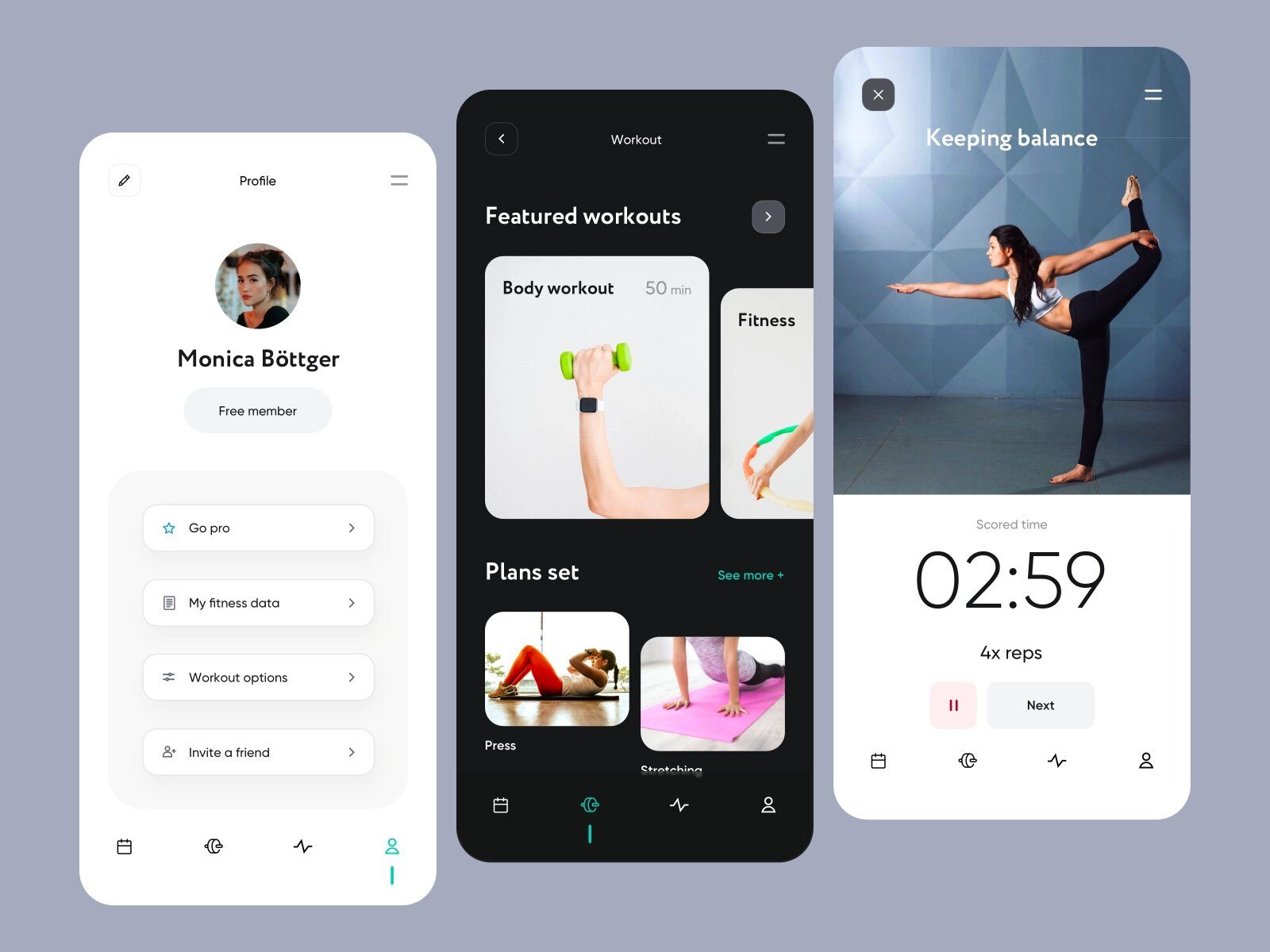
A lot of regular gym equipment can be modified with IoT technology (image by Outcrowd)
Alternatively, you can partner up with device providers that make existing non-IoT exercise equipment smart. For example, North Pole Engineering offers a special sensor that connects almost any treadmill with any fitness app.
Virtual Reality Devices 🥽
IoT in the fitness industry can be further advanced by incorporating VR technologies. There are some options on the market that allow users to have a fully immersive workout experience or take part in a whole virtual marathon while wearing a VR headset.
This video is a promotion of the new Oculus Quest that offers customers to exercise while playing VR games — fighting monsters, standing high in the mountains with your personal coach, slicing flying objects and trying to avoid them, etc.
There aren’t that many VR headset providers on the market, especially those who provide high-level experiences, so be prepared to work with market leaders and have quite a budget for that. It can also be HTC, Samsung, Pimax.
Alternatively, you can partner up with a company that offers headsets for watching 360° videos (Vizor Pro, for example), make some workouts following the technology requirements, and provide a more affordable experience.
APIs & SDKs for Fitness 📦
Some companies/device producers offer businesses to buy their SDKs (a development kit) and/or APIs (a set of protocols that are used for building and integrating software). This way, businesses can implement a certain functionality into their apps without having to code extra features for that.

APIs and SDKs are an easy way to implement wearable devices into a fitness app (image by Aki Tanninen)
Let’s take a look at what options there are on the market:
- For smartwatches and fitness tracker integration, you can use Apple HealthKit API, Garmin Health API, Fitbit API, etc.
- If you’d like to have nutrition planning and control functionality, take a look at Can I Eat It API, Nutrition API, Nutritics, etc.
- For distance tracking and navigation, you can use such APIs as Google Maps, Apple MapKit, and Mapbox.
- If you’d like to have a workout planning feature, you can use calendar APIs from Google, Nylas, Cronofy, etc.
- In case you might need/want your users to conduct payments via the app or website, you’ll need a banking API. Some of the most trustworthy providers are SolarisBank, Braintree, Stripe. You can also check if your local banks provide similar services.
By the way, we have an article that explains how you can make fitness APIs share data with your app in detail:
Read Also
How to Enable Google Fit, Apple’s HealthKit, and Other Services to Share Data with Your App
How to Choose the Right Partner to Integrate With? 💼
To find a suitable partner for your fitness app business idea, there’s a bunch of factors you should take into account:
- Price.
- Reviews & feedback from current/former clients.
- Maintenance accessibility.
- Diversity of services & others.

Finding the right partner takes quite a lot of time but is definitely worth it! (image by Teo Bichinashvili)
Another important aspect you should pay attention to is their specialization. First of all, make sure to check if the partners you’re looking for are suitable for your target audience. For example, if you want to target beginners in fitness, it’s not that reasonable for you to invest in smart clothing like such from Ambiotex or Komodo — what they care about in the first place is building a consistent exercise routine.
We as a IoT App Development company want to give you some ideas and inspiration with this article. But, surely, further research is inevitable since nobody knows your business idea better than you. If you’d like to get more detailed feedback from us, feel free to contact us with a detailed description of your use case.
❓ FAQ on IoT in Fitness
In this section, we’d like to cover some questions regarding the Internet of Things for the fitness industry.
In case you’ll have any questions left, feel free to contact us!
# 1: Does Using Internet of Things Devices Statistically Improve Business Metrics?
First things first, it’s quite hard to imagine the fitness industry without any IoT devices. On average, 40% of a country’s population own a smartwatch, heath, or fitness tracker — meaning that making your app compatible with such things is highly recommended. However, while high-tech devices are something that can help you stand out, they’re definitely not a must.
{ rel="nofollow" target="_blank" .default-md}*)](https://cdn.sanity.io/images/ordgikwe/production/38cbb3ddcdafc49d778805af529a8cf44dffb74e-1600x1200.jpg?w=1600&h=1200&auto=format)
In case you doubt whether IoT technology will improve your business, it will definitely can help you provide high-quality services and increase revenue in the long run (image by RD UX/UI)
If we’re talking about statistics, there’s no publicly available data that shows us how revenue increases after integrating Internet of Things devices. However, let’s take a look at some of the most widely used fitness apps. So, the top ones are Fitbit, Garmin, DribbleUp, Nike Run Club, and Zepp for App Store and Fitbit, Garmin, Planet Fitness Workouts, VeryFitPro, and Google Fit for Google Play Store.
We took the US market as an indicator. You can change the country in the filter setting and go for the one of your choice to see data that’s more relevant to you.
Each one of these apps has IoT integrations possible — at the very least, users are able to connect their currently used devices to the apps. Consequently, we can’t say for sure that implementing IoT systems will definitely increase your revenue or business metrics. However, it’s 100% something that helps to keep up with the competition. Plus, the fact that fitness apps with the biggest clientele have such technology should count for something.
# 2: Is Building your own IoT Device Worth It?
If you want to build an IoT device on your own, it’s always a good idea to know what options are there on the market since doing it yourself is quite a challenge. To begin with, you’ll need hardware elements (sensors, in the first place) that would communicate with the environment. For that communication to happen, you have to configure the hardware and implement the necessary protocols.
For that matter, you surely need decent technical and coding knowledge. If you don’t have a team with the required skills, you might have to additionally hire specialists. You’ll also need to find a server where the device will transfer/receive/store data to/from/on (the server also needs to be set up).

The market offers quite a lot of ready-to-use IoT technology-based devices (image by Ka Lee)
This is only the tip of the iceberg. So, building it yourself is definitely quite a challenge. Whether it’s worth it or not isn’t in our power to decide since you know your company’s capabilities best. However, if we were to integrate a certain IoT device, we wouldn’t create it on our own.
Most companies who offer IoT fitness equipment or wearables and dedicated app work with third-party manufacturers who build branded devices for them or use APIs/SDKs in case it’s just a question of functionality, thus also considering the challenges of securing IoT devices when outsourcing development. If you follow this strategy, you can significantly decrease Time-to-Market and IoT app development cost while providing the value you want.
💡 Takeaways
To sum up, the fitness industry is highly diverse. Apart from hundreds of fitness branches you might operate at, there are thousands of technologies and devices that can improve your services and help you be that one company everyone talks about.
Surely, it costs money, it requires time, but spending a decent amount of time researching the IoT fitness market is 100% worth it. If you’re looking for a Tech Partner, feel free to contact us any time to ask questions!
Was it helpful?
Read also

10 Innovative Fitness Application Ideas: Revolutionizing Personal Health and Wellness

How to Add AI to Your App: Guide With Examples

How to Develop a Wellness App: Case Study-Based Guide
Our clients say
![Stormotion client Alexander Wolff, CPO from [object Object]](/static/a16ba3c9580effc3ab9a68d115eadffe/b0e74/alex.png)
When I was working with Stormotion, I forgot they were an external agency. They put such effort into my product it might as well have been their own. I’ve never worked with such a client-focused company before.
Alexander Wolff, CPO
Sjut

